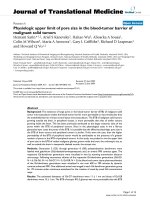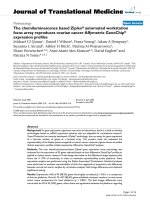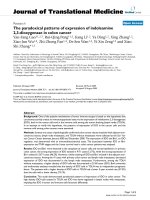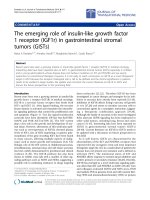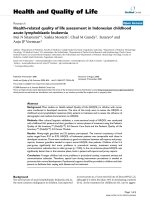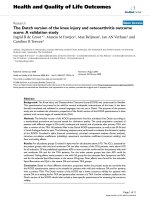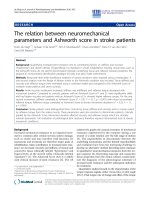báo cáo hóa học:" The paradoxical patterns of expression of indoleamine 2,3-dioxygenase in colon cancer" docx
Bạn đang xem bản rút gọn của tài liệu. Xem và tải ngay bản đầy đủ của tài liệu tại đây (776.56 KB, 8 trang )
BioMed Central
Page 1 of 8
(page number not for citation purposes)
Journal of Translational Medicine
Open Access
Research
The paradoxical patterns of expression of indoleamine
2,3-dioxygenase in colon cancer
Yan-Fang Gao
†1,2,3
, Rui-Qing Peng
†1,2
, Jiang Li
1,2
, Ya Ding
1,2
, Xing Zhang
1,2
,
Xiao-Jun Wu
1,4
, Zhi-Zhong Pan
1,4
, De-Sen Wan
1,4
, Yi-Xin Zeng
1,2
and Xiao-
Shi Zhang*
1,2
Address:
1
State Key Laboratory of Oncology in South China, 651 Dongfeng R E, 510060, Guangzhou, PR China,
2
Biotherapy Center, Cancer
Center, Sun Yat-sen University, 651 Dongfeng R E, 510060, Guangzhou, PR China,
3
Department of Medical Oncology, Weifang People's Hospital,
151 Guangwen Street, Kuiwen District, 261040, Weifang, PR China and
4
Department of Abdominal Oncology, Cancer Center, Sun Yat-sen
University, 651 Dongfeng R E, 510060, Guangzhou, PR China
Email: Yan-Fang Gao - ; Rui-Qing Peng - ; Jiang Li - ;
Ya Ding - ; Xing Zhang - ; Xiao-Jun Wu - ; Zhi-
Zhong Pan - ; De-Sen Wan - ; Yi-Xin Zeng - ; Xiao-
Shi Zhang* -
* Corresponding author †Equal contributors
Abstract
Background: One of the putative mechanisms of tumor immune escape is based on the hypothesis that
carcinomas actively create an immunosuppressed state via the expression of indoleamine 2,3-dioxygenase
(IDO), both in the cancer cells and in the immune cells among the tumor-draining lymph nodes (TDLN).
In an attempt to verify this hypothesis, the patterns of expression of IDO in the cancer cells and the
immune cells among colon cancers were examined.
Methods: Seventy-one cases of pathologically-confirmed colon cancer tissues matched with adjacent non-
cancerous tissues, lymph node metastases, and TDLN without metastases were collected at the Sun Yat-
sen Cancer Center between January 2000 and December 2000. The expression of IDO and Bin1, an IDO
regulator, was determined with an immunohistochemical assay. The association between IDO or Bin1
expression and TNM stages and the 5-year survival rate in colon cancer patients was analyzed.
Results: IDO and Bin1 were detected in the cytoplasm of cancer cells and normal epithelium. In primary
colon cancer, the strong expression of IDO existed in 9/71 cases (12.7%), while the strong expression of
Bin1 existed in 33/71 cases (46.5%). However, similar staining of IDO and Bin1 existed in the adjacent non-
cancerous tissues. Among the 41 cases with primary colon tumor and lymph node metastases, decreased
expression of IDO was documented in the lymph node metastases. Furthermore, among the TDLN
without metastases, a higher density of IDO
+
cells was documented in 21/60 cases (35%). Both univariate
and multivariate analyses revealed that the density of IDO
+
cells in TDLN was an independent prognostic
factor. The patients with a higher density of IDO
+
cells in TDLN had a lower 5-year survival rate (37.5%)
than the cells with a lower density (73.1%).
Conclusion: This study demonstrated paradoxical patterns of expression of IDO in colon cancer. The
high density IDO
+
cells existed in TDLN and IDO was down-regulated in lymph nodes with metastases,
implying that IDO in tumor and immune cells functions differently.
Published: 20 August 2009
Journal of Translational Medicine 2009, 7:71 doi:10.1186/1479-5876-7-71
Received: 30 March 2009
Accepted: 20 August 2009
This article is available from: />© 2009 Gao et al; licensee BioMed Central Ltd.
This is an Open Access article distributed under the terms of the Creative Commons Attribution License ( />),
which permits unrestricted use, distribution, and reproduction in any medium, provided the original work is properly cited.
Journal of Translational Medicine 2009, 7:71 />Page 2 of 8
(page number not for citation purposes)
Background
Most dietary tryptophan enters the kynurenine pathway,
leading to the biosynthesis of NAD or resulting in the
complete oxidation of amino acids for energy production.
Indoleamine 2,3-dioxygenase (IDO) and tryptophan 2,3-
dioxygenase (TDO) can both function as the initial rate-
limiting enzymes in the kynurenine pathway. Since IDO
is expressed in various tissues, while TDO is localized
almost exclusively in the liver, IDO appears to play a
much more significant role in the kynurenine pathway
than TDO [1-3]. Under physiologic conditions, IDO is
expressed modestly, but it is highly induced by bacterial
and viral infections [4].
Several lines of evidence from an experimental mouse
model showed that IDO had immmunoregulatory poten-
tial. First, placental IDO plays a crucial role in maternal-
tolerance of the fetus [5,6]. Second, the activity of IDO
results in significant prolongation of graft survival of allo-
grafted pancreas islets [7,8]. Finally, T cell-mediated
experimental asthma is inhibited by the up-regulation of
pulmonary IDO [9]. With respect to tumors, one of the
mechanisms concerning tumor immune escape might be
IDO-dependent. Indeed, animal tumors expressing a
higher level of IDO effectively escape from immune sur-
veillance of the host by degrading local tryptophan, which
in turn inhibits T cell responses [10,11]. Furthermore,
IDO expression has been documented in multiple solid
human tumors, such as brain, breast, lung, thyroid, liver,
pancreas, colon, rectum, kidney, bladder, prostate, ovar-
ian, cervix, endometrium, and skin tumors [10,12-21]. In
addition, IDO is expressed in tumor-draining lymph
nodes (TDLN). It is widely thought that either or both of
these sites of IDO expression serve to inhibit immune
responses to tumors, although the supporting evidence is
insufficient [22-25].
Based on the immunoregulatory effect of IDO, the anti-
IDO therapeutic approach has been under investigation.
Preliminary results have revealed that inhibition of IDO
could delay tumor progression in a combined setting [26-
29]. However, one should bear in mind that IDO exhibits
multiple activities. For example, the kynurenine pathway
is essential for cell biosynthesis. The IFN-γ-induced IDO-
dependent antimicrobial effect against Toxoplasma gondii,
Chlamydia psittaci, and group B streptococcal infections is
postulated to be secondary to the degradation of the
essential amino acid, L-tryptophan [30]. Additionally, the
role of IDO in the antitumor activity of human IFN-γ
remains controversial [31-33]. Therefore, more attention
should be paid to the effect of IDO inhibition [34-36]. To
test whether IDO activity in cancer cells and TDLN partic-
ipates synchronously in tumor progression, the current
study analyzed the expression of IDO in cancer cells from
primary tumor and lymph node metastases, in normal
epithelium from adjacent non-cancerous tissues, and in
immune cells from TDLN without tumor involvement in
colon cancer. The results showed the paradoxical patterns
of expression of IDO; specifically, both a higher density of
IDO
+
cells in TDLN and down-regulation of IDO in meta-
static cancer cells were associated with poor prognosis in
colon cancers.
Methods
Materials
Seventy-one cases of pathologically-confirmed specimens
were obtained from colon cancer patients who underwent
radical resection between January 2000 and December
2000 in the Cancer Center of Sun Yat-Sen University,
Guangzhou, China (Table 1). All of the patients were
treated with 5-FU-based adjuvant chemotherapy postop-
eratively for 6 months. Patients were evaluated every 3
months during the 1
st
year, every 6 months in the 2
nd
year,
and by telephone or mail communication once every year
thereafter, for a total of 5 years. If recurrence or metastasis
occurred, 5-FU-based chemotherapy was given according
to the NCCN guideline. Overall survival was defined as
the time from surgery to death; alternatively, censoring
was done at the last known date the patient was alive.
Immunohistochemical assay and scoring systems
The expression of IDO in primary tumors matched with
adjacent non-cancerous tissues, lymph node involvement,
and TDLN without tumor metastases was determined
with an immunohistochemical assay. The expression of
Bin1 in primary tumors matched with adjacent non-can-
cerous tissues was also determined with an immunohisto-
chemical assay. Briefly, formalin-fixed, paraffin-
embedded archived tissues were cut into 4-μm sections.
Then, the sections were dewaxed, rehydrated, blocked
Table 1: Patient Characteristics (N = 71)
Characteristic No. of patients(%)
Age, years
< 60 44(62.0)
≥ 60 27(38.0)
Gender
Male 46(64.8)
Female 25(35.2)
T stage
T1 1(1.4)
T2 15(21.1)
T3 54(76.1)
T4 1(1.4)
N stage
N0 27(38.0)
N1–3 44(62.0)
M stage
M0 58(81.7)
M1 13(18.3)
Journal of Translational Medicine 2009, 7:71 />Page 3 of 8
(page number not for citation purposes)
with hydrogen peroxide, and antigen was retrieved in a
microwave in 10 mM citrate buffer (pH 6.0) for 10 min-
utes and cooled to room temperature. After blocking with
1% rabbit (or sheep) serum, the sections were incubated
with sheep polyclonal antibody against human IDO at a
dilution of 1: 50 (Hycult Biotechology, Uden, The Nether-
lands) or mouse monoclonal antibody against human
Bin1 at a dilution of 1:100 (Millipore Corporation, MA,
USA) overnight at 4°C, followed by biotinylated second-
ary antibody and streptavidin-biotinylated horseradish
peroxidase complex. The sections were developed with
diaminobenzidine tetrahydrochloride (DAB) and coun-
terstained with hematoxylin. Negative controls were
made with primary antibody replaced by PBS.
The following two scoring systems were used: 1) determi-
nation of the expression of IDO and Bin1 in cancer cells
and normal epithelium; and 2) determination of the den-
sity of IDO
+
immune cells in TDLN. Each section was
scored independently by two pathologists. If inconsist-
ency existed, a third pathologists served to achieve con-
sensus. In tumor and normal epithelium, the expression
of IDO and Bin1 was interpreted for immunoreactivity
using the 0–4 semi-quantitative system of Gastl [37] for
both the intensity of staining and the percentage of posi-
tive cells (labeling frequency percentage). The intensity of
membrane staining was grouped into the following 4 cat-
egories: no staining/background of negative controls
(score = 0), weak staining detectable above background
(score = 1), moderate staining (score = 2), and intense
staining (score = 3). The labeling frequency was scored as
0 (≤ 5%), 1 (5% to 25%), 2 (26% to 50%), 3 (51% to
75%), and 4 (≥ 76%). The product index was obtained by
multiplying the intensity and percentage scores, as fol-
lows: (-), (+), (++), and (+++) indicated sum indexes of
0~2, 3~5, 6~8, and 9~12, respectively; (-) and (+) were
defined as no or modest expression, and (++) and (+++)
were defined as strong expression.
For the density of IDO
+
cells in TDLN, another scoring sys-
tem was used. Slides were examined under a low power (×
40~×100) microscope to identify the regions containing
the highest percentage of IDO
+
cells (hot spot) in the
lymph nodes. Five fields of hot spots within the lymph
nodes were selected under a higher power (×200) micro-
scope, and the average number IDO
+
cells in each field was
calculated. The cases with ≤ 50 IDO
+
cells in each field
were considered to have a low density of IDO
+
cells in the
TDLN, whereas the cases with > 50 IDO
+
cells in each field
were considered to have a high density of IDO
+
cells in the
TDLN.
Statistical analysis
The levels of IDO and Bin1 between primary tumor and
adjacent epithelium or the levels of IDO between primary
tumors and matched lymph node metastases were ana-
lyzed with a chi-square test or Fisher's exact test. The cor-
relation between IDO expression and Bin1 expression, or
the correlation between IDO expression or Bin1 expres-
sion and TNM stages was analyzed with Spearman rank
correlation. The following factors were assessed with both
univariate and multivariate analyses to determine the
influence on overall survival: T stage, N stage, M stage,
IDO expression in the primary tumor, Bin1 expression in
the primary tumor, and the density of IDO
+
cells in TDLN
without metastases. Kaplan-Meier curves were used to
estimate the distributions of those variables to survival
and compared with the log-rank test. The Cox regression
model was used to correlate assigned variables with over-
all survival. All statistical analyses were carried out using
SPSS 13.0 software (SPSS Inc., Chicago, IL, USA). Statisti-
cal significance was assumed for a two-tailed P < 0.05.
Results
The patterns of expression of IDO and Bin1
The expression of IDO was detected in the cytoplasm of
tumor cells, normal epithelium, and immune cells. The
staining of IDO occurred on both the luminal and basal
surfaces of tumor cells and normal epithelial cells. In the
same section, staining of IDO occurred both in cancer
cells and normal epithelial cells (Fig. 1A, B). Similar stain-
ing of IDO also occurred in the tumor cells which had
metastasized to the lymph nodes. As most of the sections
lacked normal lymph tissue around the nests of cancer
cells, the density of IDO
+
immune cells around the metas-
tases was not available (Fig. 1C). The expression of IDO
was detected on dendritic cell-like cells in the TDLN with-
out metastases, which were derived from 27 patients with-
out lymph node involvement (N0) and 33 patients with
lymph node involvement (N1–3; Fig. 1D). According to
the definition regarding the density of IDO
+
cells in TDLN
(vide supra), 21 cases were grouped as high density
IDO
+
cells in TDLN and 39 cases as low density of
IDO
+
cells. Bin1 was also detected in the cytoplasm in the
primary tumors and adjacent non-cancerous epithelium
(Fig. 1E, F).
Comparison of the expression of IDO and Bin1 between primary
tumors and lymph node metastases
Strong expression (++~+++) of IDO was documented in 9
of the 71 patients, while strong expression of Bin1 was
documented in 33 cases. Since IDO stained both on the
primary tumor cells and the normal epithelial cells, the
levels of IDO between primary tumors and matched adja-
cent epithelium was compared; no difference existed
(Table 2). The intensity of IDO between primary tumors
and lymph node involvement was compared among the
41 cases which have matched primary tumors and lymph
node involvements, and showed that the expression of
IDO in lymph node involvement decreased (Table 3). The
Journal of Translational Medicine 2009, 7:71 />Page 4 of 8
(page number not for citation purposes)
Expression of IDO and Bin1 in colon cancerFigure 1
Expression of IDO and Bin1 in colon cancer. IDO is expressed in primary colon cancer cells (A), in adjacent non-cancer-
ous epithelium (B) in lymph node metastases (C), and in tumor-draining lymph nodes without metastasis (D). Bin1 is also
expressed in cancer cells and epithelium (E, F; immunohistochemical assay, ×200).
AB
CD
EF
Journal of Translational Medicine 2009, 7:71 />Page 5 of 8
(page number not for citation purposes)
relationship between the levels of IDO and Bin1 was ana-
lyzed and failed to show any correlation (data not
shown).
Relationship between survival and TNM stages; the levels of IDO and
Bin1 assessed with univariate survival analysis
By the end of the 5-year follow-up, 39 patients were still
alive, thus the 5-year survival rate in this group of patients
was 55%. Before univariate and multivariate analyses, the
correlation between the level of IDO or Bin1 with the
TNM stages was analyzed. Neither IDO nor Bin1 expres-
sion correlated with TNM stages (data not shown). Then,
the TNM stages, and the levels of IDO and Bin1 were ana-
lyzed with Kaplan-Meier survival analysis. The results
showed that N stage, M stage, and the density of IDO
+
cells
in TDLN indicated a poor prognosis, whereas the T stage
and the levels of IDO and Bin1 in primary tumors were
not related to survival. The patients with a higher density
of IDO
+
cells in TDLN had a lower 5-year survival rate
(37.5%) than the patients with a lower density of
IDO
+
cells in TDLN (73.1%; Fig. 2).
Relationship between survival and the TNM stages, and the levels of
IDO and Bin1 assessed with multivariate survival analysis
The Cox regression model revealed that patients with a
higher N stage, a higher M stage, and a higher density of
IDO
+
cells in TDLN without tumor involvement had a
shorter survival, whereas no relationship was observed
between the survival and T stage as well as the levels of
IDO and Bin1 in primary tumors, indicating that in this
group of patients the density of IDO
+
cells in TDLN with-
out tumor involvement were independently prognostic
(Table 4).
Discussion
To determine the role of IDO activity in the progression of
colon cancers, this study analyzed the expression of IDO
in tumor cells from primary tumors and lymph node
metastases, in normal epithelial cells from non-cancerous
tissues, and in immune cells from the TDLN. The results
showed that a higher density of IDO
+
cells in TDLN was
associated with a lower 5-year survival rate, which was a
prognostic marker independent of TNM stage, although
the T stage was not related to survival in this group of
patients, which might derive from the obvious bias of T
stage, with only one T1 and T4 patient studied. In con-
trast, as compared with non-cancer tissues, the increased
expression of IDO was not observed in primary tumors.
However, the decreased level of IDO was documented in
lymph nodes metastases. These data suggest that the activ-
ity of IDO in tumor cells and immune cells differs.
Although the expression of IDO in TDLN has been
observed in human tumors, the prognostic role of IDO in
TDLN has only been documented in melanoma [24-27].
Among melanomas, the IDO
+
cells in TDLN appeared to
be a population of plasmacytoid dendritic cell-like cells
which blocked the initial response to tumor antigens,
inhibited the ability of activated T cells to kill tumor cells,
and enhanced the suppressive activity of T regulatory cells,
resulting in local immunosuppression [38-42]. Except for
melanoma, a highly immunogenic tumor, the prognostic
effect of the density of IDO
+
cells in TDLN among other
solid tumors, such as colorectal cancer, with modest
immunogenicity is still elusive. This study revealed that
the patients with a higher density of IDO
+
cells in TDLN
had a lower 5-year survival rate (37.5%) than patients
with a lower density of IDO
+
cells (73.1%), implying that
the IDO in TDLN contributes to tumor progression,
regardless of the immunogenicity of the primary tumors.
Furthermore, this study also indicated that the IDO
+
cells
in TDLN were not induced directly by the tumor cells as
tumor cells were absent in these lymph nodes. The higher
density of IDO
+
cells in TDLN might be ascribed to cancer
cell-induced cytokines, exosomes, and tolerogenic den-
dritic cells which migrated from the primary tumor to the
TDLN [43-48].
Considering the fact that IDO was also expressed in nor-
mal epithelium, the levels of IDO between primary
Table 2: The expression of IDO or Bin1 in primary tumors and matched adjacent non-cancerous epithelium (N = 71)
IDO expression P value Bin1 expression P value
- + ++ +++ - + ++ +++
Primary tumor
(%)
40
(56.3)
22
(31.0)
6
(8.5)
3
(4.2)
0.936 21
(29.6)
17
(23.9)
19
(26.8)
14
(19.7)
0.350
Adjacent epithelium
(%)
42
(59.2)
20
(28.1)
7
(9.9)
2
(2.8)
12
(16.9)
19
(26.8)
22
(31.0)
18
(25.3)
Table 3: The expression of IDO in primary tumors and matched
lymph node metastases (N = 41)
IDO expression P value
- + ++ +++
Primary tumor (%) 18
(43.9)
15
(36.6)
6
(14.6)
2
(4.9)
0.020
Metastasis(%) 27
(65.9)
14
(34.1)
00
Journal of Translational Medicine 2009, 7:71 />Page 6 of 8
(page number not for citation purposes)
tumors and its adjacent non-cancerous tissues were com-
pared in this study. The results showed that no difference
in IDO expression was observed. Secondly, as Bin1 could
regulate the transcription of IDO, the Bin1 expression was
also examined [49,50]. Again, no relationship between
Bin1 expression and IDO expression was observed.
Finally, neither IDO nor Bin1 in primary colon cancers
was associated with the 5-year survival rate. Thus, these
data suggested that it was less likely that the IDO activity
in primary colon cancers contributed to tumor progres-
sion, which contrasted to the previous observation [13].
This discrepancy might derive from the research strategy
as the IDO expression in the adjacent tissue might not
been carefully evaluated in the previous study.
The expression of IDO in cancer cells is associated with a
poor prognosis, as documented in multiple solid tumors.
In this study, as the up-regulation of IDO was not
Table 4: The association between survival and TNM stages, and the levels of IDO and Bin1 in patients with colon cancers (N = 60)
Factors B SE Wald df Sig. Exp(B) 95%CI
Lower upper
T stage 118 .389 .091 1 .763 .889 .415 1.906
N stage .825 .258 10.220 1 .001 2.281 1.376 3.783
M stage 3.212 .579 30.821 1 .000 24.830 7.989 77.173
IDO expression in primary tumors .598 .638 .878 1 .349 1.818 .521 6.345
Bin1 expression in primary tumors 241 .378 .405 1 .525 .786 .375 1.650
The density of IDO+cells in TDLN 1.321 .524 6.362 1 .012 3.746 1.342 10.452
The association of overall survival with the density of IDO
+
cells in TDLN in colon cancersFigure 2
The association of overall survival with the density of IDO
+
cells in TDLN in colon cancers. The patients with a low
density of IDO
+
cells in TDLN were strongly associated with a higher 5-year survival rate (73.1%) than the patients with a high
density of IDO
+
cells (37.5%; Kaplan-Meier analysis, P < 0.05).
Journal of Translational Medicine 2009, 7:71 />Page 7 of 8
(page number not for citation purposes)
observed in primary cancers, it is impossible to judge
whether IDO activity is involved in tumor progression.
Therefore, this study further compared the levels of IDO
between primary tumors and matched lymph node
metastases. Decreased expression of IDO was observed in
lymph node metastases. Since lymph node involvement
contributed to poor survival, decreased IDO in lymph
node metastases do not support the hypothesis that IDO
expressed by metastatic cancer cells contributes to metas-
tasis by direct induction of local immunosuppression [51-
55]. Therefore, these data suggest that IDO might have
other potential than immunosuppression in metastatic
colon cancer cells, although more evidence is needed to
confirm this hypothesis. Based on the potential pluripo-
tency of IDO, more specific IDO inhibitor might be
needed for tumor therapy [56].
Conclusion
This study observed the paradoxical patterns of IDO
expression in colon cancer. One was the fact that a higher
density of IDO
+
cells existed in TDLN, the other was the
fact that the down-regulation of IDO occurred in meta-
static colon cancer cells. This paradoxical phenomenon
implied that IDO activity might contribute to the progres-
sion of colon cancer by multiple mechanisms including
immunosuppression.
Competing interests
The authors declare that they have no competing interests.
Authors' contributions
WXJ, DY, ZX, PZZ, and WDS carried out the cases collec-
tion, GYF and PRQ carried out the immunohistochemical
staining work and analysis, ZXS and LJ conceived the
study, participated in its design and coordination, and
helped draft the manuscript. All authors read and
approved the final manuscript.
Acknowledgements
This study was supported by the National Nature Science Foundation
(30872931) and the Nature Science Foundation of Guangdong Province,
China (05001693).
References
1. Munn DH, Mellor AL: Indoleamine 2,3-dioxygenase and tumor-
induced tolerance. J Clin Invest 2007, 117(5):1147-1154.
2. Takikawa O: Biochemical and medical aspects of the
indoleamine 2,3-dioxy-genase-initiated L-tryptophan metab-
olism. Biochem Biophys Res Commun 2005, 338(1):12-19.
3. King NJ, Thomas SR: Molecules in focus: indoleamine 2,3-diox-
ygenase. Int J Biochem Cell Biol 2007, 39(12):2167-2172.
4. Munn DH: Indoleamine 2,3-dioxygenase, tumor-induced tol-
erance and counter-regulation. Curr Opin Immunol 2006,
18(2):220-225.
5. Munn DH, Zhou M, Attwood JT, Bondarev I, Conway SJ, Marshall B,
Brown C, Mellor AL: Prevention of allogeneic fetal rejection by
tryptophancatabolism. Science 1998, 281(5380):1191-1193.
6. Mellor AL, Munn DH: IDO expression by dendritic cells: toler-
ance and tryptophan catabolism. Nat Rev Immunol 2004,
4(10):762-774.
7. Alexander AM, Crawford M, Bertera S, Rudert WA, Takikawa O,
Robbins PD, Trucco M: Indoleamine 2,3-dioxygenase expres-
sion in transplanted NOD Islets prolongs graft survival after
adoptive transfer of diabetogenic splenocytes. Diabetes 2002,
51(2):356-365.
8. Jalili RB, Rayat GR, Rajotte RV, Ghahary A: Suppression of islet all-
ogeneic immune response by indoleamine 2,3 dioxygenase-
expressing fibroblasts. J Cell Physiol 2007, 213(1):137-143.
9. Hayashi T, Beck L, Rossetto C, Gong X, Takikawa O, Takabayashi K,
Broide DH, Carson DA, Raz E: Inhibition of experimental
asthma by indoleamine 2,3-dioxygenase. J Clin Invest 2004,
114(2):270-279.
10. Uyttenhove C, Pilotte L, Théate I, Stroobant V, Colau D, Parmentier
N, Boon T, Eynde BJ Van den: Evidence for a tumoral immune
resistance mechanism based on tryptophan degradation by
indoleamine 2,3-dioxygenase. Nat Med 2003, 9(10):1269-1274.
11. Zheng X, Koropatnick J, Li M, Zhang X, Ling F, Ren X, Hao X, Sun H,
Vladau C, Franek JA, Feng B, Urquhart BL, Zhong R, Freeman DJ, Gar-
cia B, Min WP: Reinstalling antitumor immunity by inhibiting
tumor-derived immuno-suppressive molecule IDO through
RNA interference. J Immunol
2006, 177(8):5639-5646.
12. Ino K, Yoshida N, Kajiyama H, Shibata K, Yamamoto E, Kidokoro K,
Takahashi N, Terauchi M, Nawa A, Nomura S, Nagasaka T, Takikawa
O, Kikkawa F: Indoleamine 2,3-dioxygenase is a novel prognos-
tic indicator for endometrial cancer. Br J Cancer 2006,
95(11):1555-1561.
13. Brandacher G, Perathoner A, Ladurner R, Schneeberger S, Obrist P,
Winkler C, Werner ER, Werner-Felmayer G, Weiss HG, Göbel G,
Margreiter R, Königsrainer A, Fuchs D, Amberger A: Prognostic
value of indoleamine 2,3-dioxygenase expression in colorec-
tal cancer: effect on tumor-infiltrating T cells. Clin Cancer Res
2006, 12(4):1144-1151.
14. Chen PW, Mellon JK, Mayhew E, Wang S, He YG, Hogan N, Nieder-
korn JY: Uveal melanoma expression of indoleamine 2,3-
deoxygenase: establishment of an immune privileged envi-
ronment by tryptophan depletion. Exp Eye Res 2007,
85(5):617-625.
15. Sedlmayr P, Semlitsch M, Gebru G, Karpf E, Reich O, Tang T, Winter-
steiger R, Takikawa O, Dohr G: Expression of indoleamine 2,3-
dioxygenase in carcinoma of human endometrium and uter-
ine cervix. Adv Exp Med Biol 2003, 527:91-95.
16. Karanikas V, Zamanakou M, Kerenidi T, Dahabreh J, Hevas A, Nakou
M, Gourgoulianis KI, Germenis AE: Indoleamine 2,3-dioxygenase
(IDO) expression in lung cancer. Cancer Biol Ther 2007,
6(8):1258-262.
17. Pan K, Wang H, Chen MS, Zhang HK, Weng DS, Zhou J, Huang W,
Li JJ, Song HF, Xia JC: Expression and prognosis role of
indoleamine 2,3-dioxygenase in hepatocellular carcinoma. J
Cancer Res Clin Oncol 2008, 134(11):1247-1253.
18. Riesenberg R, Weiler C, Spring O, Eder M, Buchner A, Popp T, Cas-
tro M, Kammerer R, Takikawa O, Hatz RA, Stief CG, Hofstetter A,
Zimmermann W: Expression of indoleamine 2,3-dioxygenase
in tumor endothelial cells correlates with long-term survival
of patients with renal cell carcinoma. Clin Cancer Res 2007,
13(23):6993-7002.
19. Takao M, Okamoto A, Nikaido T, Urashima M, Takakura S, Saito M,
Saito M, Okamoto S, Takikawa O, Sasaki H, Yasuda M, Ochiai K, Tan-
aka T: Increased synthesis of indoleamine-2,3-dioxygenase
protein is positively associated with impaired survival in
patients with serous-type, but not with other types of, ovar-
ian cancer. Oncol Rep 2007, 17(6):1333-1339.
20. Travers MT, Gow IF, Barber MC, Thomson J, Shennan DB:
Indoleamine 2,3-dioxygenase activity and L-tryptophan
transport in human breast cancer cells. Biochim Biophys Acta
2004, 1661(1):106-12.
21. Ino K, Yamamoto E, Shibata K, Kajiyama H, Yoshida N, Terauchi M,
Nawa A, Nagasaka T, Takikawa O, Kikkawa F: Inverse correlation
between tumoral indoleamine 2,3-dioxygenase expression
and tumor-infiltrating lymphocytes in endometrial cancer:
its association with disease progression and survival. Clin Can-
cer Res 2008, 14(8):2310-2317.
22. Munn DH, Mellor AL: The tumor-draining lymph node as an
immune-privileged site. Immunol Rev 2006, 213:146-158.
23. Terness P, Chuang JJ, Opelz G: The immunoregulatory role of
IDO-producing human dendritic cells revisited. Trends Immu-
nol 2006, 27:68-73.
Publish with Bio Med Central and every
scientist can read your work free of charge
"BioMed Central will be the most significant development for
disseminating the results of biomedical researc h in our lifetime."
Sir Paul Nurse, Cancer Research UK
Your research papers will be:
available free of charge to the entire biomedical community
peer reviewed and published immediately upon acceptance
cited in PubMed and archived on PubMed Central
yours — you keep the copyright
Submit your manuscript here:
/>BioMedcentral
Journal of Translational Medicine 2009, 7:71 />Page 8 of 8
(page number not for citation purposes)
24. Löb S, Königsrainer A: Is IDO a key enzyme bridging the gap
between tumor escape and tolerance induction? Langenbecks
Arch Surg 2008, 393(6):995-1003.
25. Negin B, Panka D, Wang W, Siddiqui M, Tawa N, Mullen J, Tahan S,
Mandato L, Polivy A, Mier J, Atkins M: Effect of melanoma on
immune function in the regional lymph node basin. Clin Can-
cer Res 2008, 14(3):654-659.
26. Yen MC, Lin CC, Chen YL, Huang SS, Yang HJ, Chang CP, Lei HY, Lai
MD: A novel cancer therapy by skin delivery of indoleamine
2,3-dioxygenase siRNA. Clin Cancer Res 2009, 15:641-649.
27. Ou X, Cai S, Liu P, Zeng J, He Y, Wu X, Du J: Enhancement of den-
dritic cell-tumor fusion vaccine potency by indoleamine-pyr-
role 2,3-dioxygenase inhibitor, 1-MT. J Cancer Res Clin Oncol
2008, 134:525-533.
28. Miyazaki T, Moritake K, Yamada K, Hara N, Osago H, Shibata T, Aki-
yama Y, Tsuchiya M: Indoleamine 2,3-dioxygenase as a new tar-
get for malignant glioma therapy. J Neurosurg 2009 in press.
29. Hou DY, Muller AJ, Sharma MD, DuHadaway J, Banerjee T, Johnson
M, Mellor AL, Prendergast GC, Munn DH: Inhibition of indoleam-
ine 2,3-dioxygenase in dendritic cells by stereoisomers of 1-
methyl-tryptophan correlates with antitumor responses.
Cancer Res 2007, 67(2):792-801.
30. MacKenzie CR, Heseler K, Müller A, Däubener W: Role of
indoleamine 2,3-dioxygenase in antimicrobial defence and
immuno-regulation: tryptophan depletion versus production
of toxic kynurenines. Curr Drug Metab 2007, 8(3):237-244.
31. Burke F, Knowles RG, East N, Balkwill FR: The role of indoleamine
2,3-dioxygenase in the anti-tumour activity of human inter-
feron-gamma in vivo. Int J Cancer 1995, 60(1):115-122.
32. Gasparri AM, Jachetti E, Colombo B, Sacchi A, Curnis F, Rizzardi GP,
Traversari C, Bellone M, Corti A: Critical role of indoleamine
2,3-dioxygenase in tumor resistance to repeated treatments
with targeted IFNgamma. Mol Cancer Ther 2008,
7(12):3859-3866.
33. Melichar B, Hu W, Patenia R, Melicharová K, Gallardo ST, Freedman
R: rIFN-gamma-mediated growth suppression of platinum-
sensitive and -resistant ovarian tumor cell lines not depend-
ent upon arginase inhibition. J Transl Med 2003, 1(1):5.
34. Karanikas V, Speletas M, Zamanakou M, Kalala F, Loules G, Kerenidi
T, Barda AK, Gourgoulianis KI, Germenis AE: Foxp3 expression in
human cancer cells. J Transl Med 2008, 6:19.
35. Slingluff CL Jr, Speiser DE: Progress and controversies in devel-
oping cancer vaccines. J Transl Med 2005, 3(1):18.
36. Nagorsen D, Voigt S, Berg E, Stein H, Thiel E, Loddenkemper C:
Tumor-infiltrating macrophages and dendritic cells in
human colorectal cancer: relation to local regulatory T cells,
systemic T-cell response against tumor-associated antigens
and survival. J Transl Med 2007, 5:62.
37. Gastl G, Spizzo G, Obrist P, Dünser M, Mikuz G: Ep-CAM overex-
pression in breast cancer as a predictor of survival. Lancet
2000, 356(9246):1981-1982.
38. Sharma MD, Baban B, Chandler P, Hou DY, Singh N, Yagita H, Azuma
M, Blazar BR, Mellor AL, Munn DH: Plasmacytoid dendritic cells
from mouse tumor-draining lymph nodes directly activate
mature Tregs via indoleamine 2,3-dioxygenase. J Clin Invest
2007, 117(9):2570-2582.
39. von Bergwelt-Baildon MS, Popov A, Saric T, Chemnitz J, Classen S,
Stoffel MS, Fiore F, Roth U, Beyer M, Debey S, Wickenhauser C,
Hanisch FG, Schultze JL: CD25 and indoleamine 2,3-dioxygen-
ase are up-regulated by prostaglandin E2 and expressed by
tumor-associated dendritic cells in vivo: additional mecha-
nisms of T-cell inhibition. Blood 2006, 108(1):228-237.
40. Munn DH, Sharma MD, Hou D, Baban B, Lee JR, Antonia SJ, Messina
JL, Chandler P, Koni PA, Mellor AL: Expression of indoleamine
2,3-dioxygenase by plasmacytoid dendritic cells in tumor-
draining lymph nodes. J Clin Invest 2004, 114(2):280-290.
41. Kahler DJ, Mellor AL: T cell regulatory plasmacytoid dendritic
cells expressing indoleamine 2,3 dioxygenase. Handb Exp Phar-
macol 2009, 188:165-196.
42. Liu JY, Zhang XS, Ding Y, Peng RQ, Cheng X, Zhang NH, Xia JC, Zeng
YX: The changes of CD4+CD25+/CD4+ proportion in spleen
of tumor-bearing BALB/c mice. J Transl Med 2005, 3(1):5.
43. Gajewski TF, Meng Y, Blank C, Brown I, Kacha A, Kline J, Harlin H:
Immune resistance orchestrated by the tumor microenvi-
ronment. Immunol Rev 2006, 213:
131-145.
44. Zou W: Regulatory T cells, tumour immunity and immuno-
therapy. Nat Rev Immunol 2006, 6(4):295-307.
45. Watanabe S, Deguchi K, Zheng R, Tamai H, Wang LX, Cohen PA, Shu
S: Tumor-induced CD11b+Gr-1+ myeloid cells suppress T
cell sensitization in tumor-draining lymph nodes. J Immunol
2008, 181(5):3291-300.
46. Polak ME, Borthwick NJ, Gabriel FG, Johnson P, Higgins B, Hurren J,
McCormick D, Jager MJ, Cree IA: Mechanisms of local immuno-
suppression in cutaneous melanoma. Br J Cancer 2007,
96(12):1879-1887.
47. Ichim TE, Zhong Z, Kaushal S, Zheng X, Ren X, Hao X, Joyce JA,
Hanley HH, Riordan NH, Koropatnick J, Bogin V, Minev BR, Min WP,
Tullis RH: Exosomes as a tumor immune escape mechanism:
possible therapeutic implications. J Transl Med 2008, 6:37.
48. Huber V, Filipazzi P, Iero M, Fais S, Rivoltini L: More insights into
the immunosuppressive potential of tumor exosomes. J
Transl Med 2008, 6:63.
49. Fallarino F, Gizzi S, Mosci P, Grohmann U, Puccetti P: Tryptophan
catabolism in IDO+ plasmacytoid dendritic cells. Curr Drug
Metab 2007, 8(3):209-216.
50. Muller AJ, DuHadaway JB, Donover PS, Sutanto-Ward E, Prendergast
GC: Inhibition of indoleamine 2,3-dioxygenase, an immu-
noregulatory target of the cancer suppression gene Bin1,
potentiates cancer chemotherapy. Nat Med 2005,
11(3):312-319.
51. Prendergast GC: Immune escape as a fundamental trait of can-
cer: focus on IDO. Oncogene 2008, 27(28):3889-3900.
52. Witkiewicz A, Williams TK, Cozzitorto J, Durkan B, Showalter SL,
Yeo CJ, Brody JR: Expression of indoleamine 2,3-dioxygenase
in metastatic pancreatic ductal adenocarcinoma recruits
regulatory T cells to avoid immune detection. J Am Coll Surg
2008, 206(5):849-54. discussion 854–6
53. Zamanakou M, Germenis AE, Karanikas V: Tumor immune escape
mediated by indoleamine 2,3-dioxygenase. Immunol Lett 2007,
111(2):69-75.
54. Yoshida N, Ino K, Ishida Y, Kajiyama H, Yamamoto E, Shibata K, Ter-
auchi M, Nawa A, Akimoto H, Takikawa O, Isobe K, Kikkawa F:
Overexpression of indoleamine 2,3-dioxygenase in human
endometrial carcinoma cells induces rapid tumor growth in
a mouse xenograft model. Clin Cancer Res 2008,
14(22):7251-7259.
55. Battaglia A, Buzzonetti A, Baranello C, Ferrandina G, Martinelli E, Fan-
fani F, Scambia G, Fattorossi A: Metastatic tumour cells favour
the generation of a tolerogenic milieu in tumour draining
lymph node in patients with early cervical cancer. Cancer
Immunol Immunother 2009, 58(9):1363-73.
56. Löb S, Königsrainer A, Rammensee HG, Opelz G, Terness P: Inhibi-
tors of indoleamine-2,3-dioxygenase for cancer therapy: can
we see the wood for the trees? Nat Rev Cancer 2009,
9(6):445-52.
